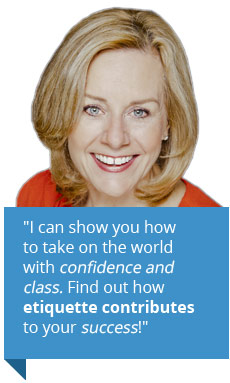Tips for Introducing Yourself – And Others
August 7, 2014 Often, people avoid introducing themselves or others, because they are uncomfortable doing so and perhaps afraid they might not follow proper protocol. In truth, it’s fairly simple: always state the name of the most honored person first. An example would be, “Melinda Gates, I would like to introduce to you my roommate, Jane Drake.”
Often, people avoid introducing themselves or others, because they are uncomfortable doing so and perhaps afraid they might not follow proper protocol. In truth, it’s fairly simple: always state the name of the most honored person first. An example would be, “Melinda Gates, I would like to introduce to you my roommate, Jane Drake.”
Then, add a snippet of information on a common interest to help them connect and begin a conversation. Add information about their career, education, place of origin, hobbies, interests, family or a host of other areas. Here is an example “Jane is in my Spanish class. She’s just returned from a trip to Cancun. Aren’t you planning a trip there this winter?”
When presenting one person to another, look at the most honored person first, then turn to the other person. Remember to distinctly pronounce the names to provide respect for those you are introducing.
If you are in a more formal setting, or when there is an obvious age difference, it’s best to use titles and last names, such as: “Mrs. Jameson, I’d like introduce to you Mr. Robertson.”
When you are introducing yourself to others, always include both your first and last name and say your name slowing so people can catch it. Then add something about yourself to help move the conversation forward. Then, ask for the other person’s name. Repeat the name of that person, such as, “It’s great to meet you, Joan.”
Always maintain eye contact with the person you’re being introduced to. Eye contact demonstrates that you are paying attention and the introduction is important to you.
Email Introductions
When introducing two people through email, here are some tips to follow:
- Like any other email, the subject line should the topic. Something like: “E-Introduction: Jane Smith and Larry Vance,” ensures that both recipients are alerted to the content.
- Most of the time, there is a specific reason for the introduction –Person One (Jane Smith) asked you to provide an introduction to Person Two (Larry Vance), for example. Open the email with something that indicates you’re making an introduction on their behalf. Then, continue with the introduction: “Larry Vance, allow me to introduce Jane Smith. Jane is a freelance designer and I think she could be of great assistance to you on your new web design project.”
- Close the email with a line that takes you out of the conversation. Something like: “I’ll let you two take it from here. All the best, Margaret Page.”
Want to learn how to keep up with etiquette challenges in our modern society? That’s where I come in! Be more confident when making introductions—and maximize your personal impact today! Find out more about business etiquette training.
 Print This Post
Print This Post
Leave a Reply




No Comments Yet
You can be the first to comment!